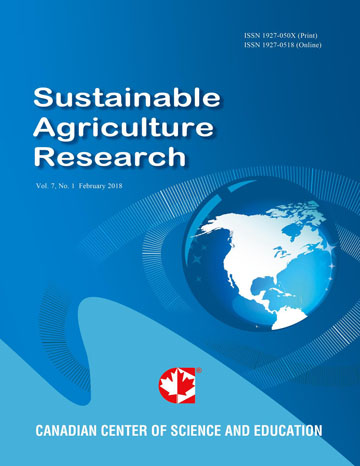Investigating the Response to Meristem Culture of Four Regional Sweetpotato Varieties in the Western Highlands of Cameroon
- Eugene L. Tatah
- Christopher T. Chi
- Balgah A. Roland
- Nardine D. Nsaidzeka
Abstract
In the Western highlands of Cameroon where sweetpotato (Ipomoea batatas L.) is an inevitable staple crop during the dry season, farmers cherish local which are presently under the risk of extinction due to accumulation of pest and diseases. Guaranteeing sustainable Sweetpotato production in this region therefore requires providing farmers with disease free planting materials such as tissue cultures. This study was conducted to investigate the feasibility of introducing disease free planting materials from meristem culture of EX-KOLB, EX-GUZANG2, EX-WIDIKUM3 and EX-NKAMBE1 which are four regional sweetpotato varieties common in the Western highlands of Cameroon. Test tubes containing growing media and meristems from each of the varieties were labeled and laid out in a completely randomized experimental design (CRD) with four replications and four treatments. Data on the number of sprouted meristems, number of rooted meristems, number of meristems contaminated, number of meristems that died, average heights of developed plants, average number of nodes on the developed plants, and average number of leaves on the developed plants was collected over a period of 8 weeks at 2 weeks interval. Meristems from all the landraces sprouted in the media used and the differences in the mean number of sprouted meristem between the landraces were significant (P<0.05). EX-GUZANG2 gave the highest mean of sprouted meristems of (2.75) and EX-WIDIKUM3 the lowest (0.75). According to ANOVA response of meristems from the four landraces to the media used differed significantly only in number sprouted, number of contaminated and number dead meristems as well as number of nodes(P<0.05). No significant differences were observed with number of contaminated and dead meristems, rooting as well plant height, number of leaves and nodes formed(P>0.05).This genotype-dependent response to media used for in vitro regeneration by plants has been observed by many studies. However meristems from EX-GUZANG2 and EX-KOLB showed greater positive respond to this media and merit further studies for the purpose of this experiment.
- Full Text:
 PDF
PDF
- DOI:10.5539/sar.v8n4p1
Index
Contact
- Joan LeeEditorial Assistant
- sar@ccsenet.org
